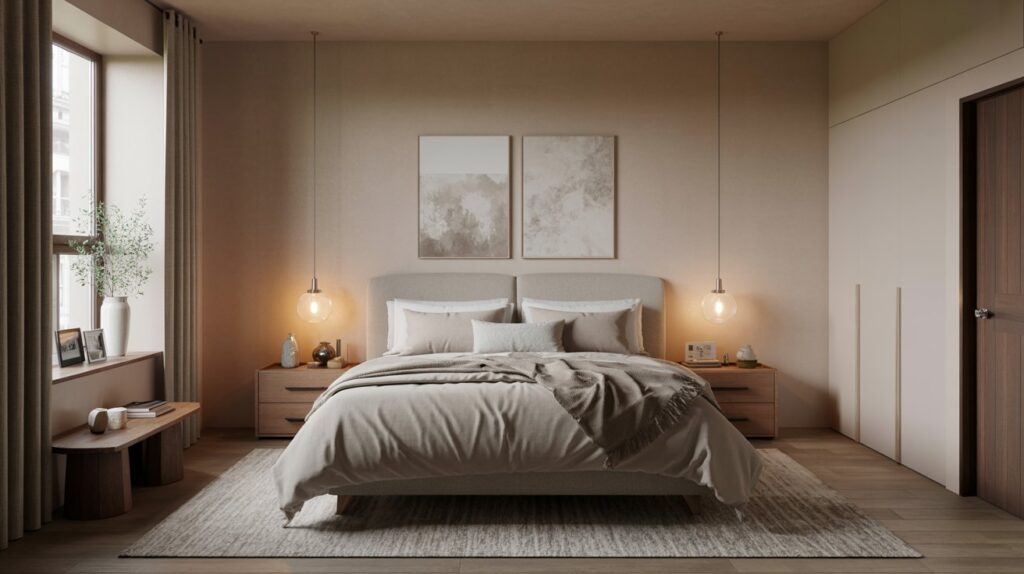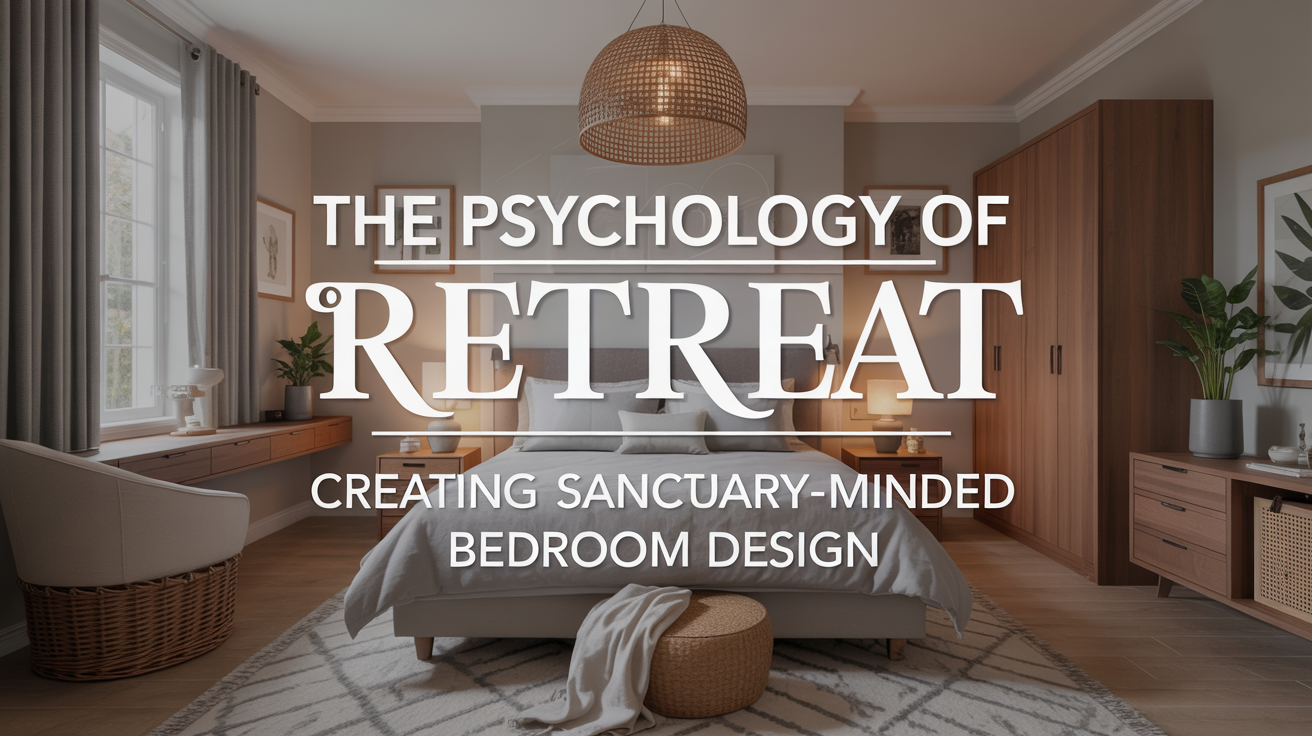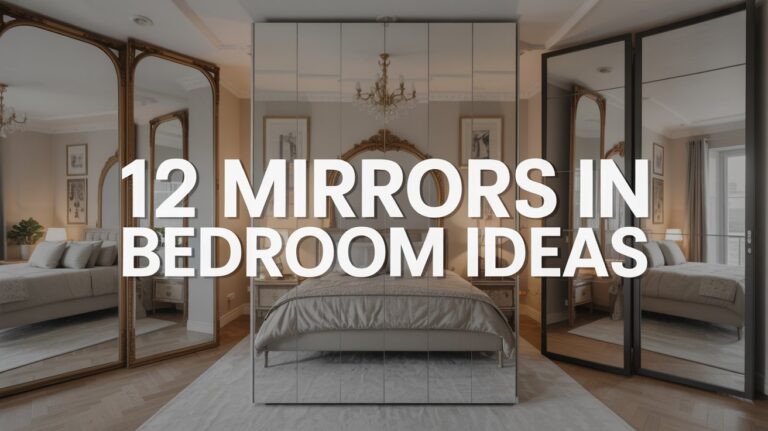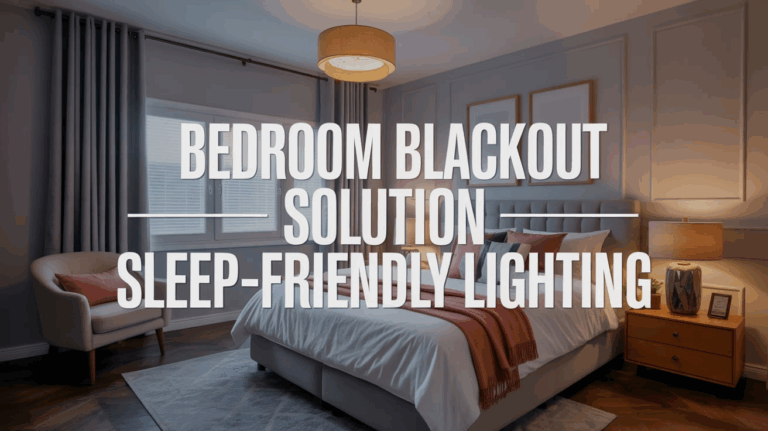The Psychology of Retreat: Creating a Sanctuary-Minded Bedroom Design
I have been, or can be if you click on a link and make a purchase, compensated via a cash payment, gift, or something else of value for writing this post. As an Amazon Associate, I earn from qualifying purchases. Please read my full Affiliate Disclosure for more information.
A sanctuary-minded bedroom quiets your mind by pairing soft, earthy colors with natural textures, anchoring you in calm. Favor muted greens, taupes, and creams, plus materials that breathe and age gracefully. Organize with clear zones—rest away from work—with minimal clutter and purposeful storage. Use warm, dimmable lighting and rituals that cue wind-down. Align furniture for flow and view, and embrace textures over ornaments to reduce distraction. If you follow this path, you’ll uncover deeper design levers for retreat.
Key Takeaways
- Use soft, earthy palette and natural textures to quiet visual noise and promote a calm, retreat-like mood.
- Separate work and rest zones with clear flow and minimal clutter to reduce cognitive load.
- Implement warm, gradual lighting and limited blue light to signal wind-down and support circadian rhythm.
- Choose breathable natural fibers and durable materials that age gracefully, enhancing perceived safety and longevity.
- Establish consistent rituals (dimming lights, soft music) to train the nervous system for rest and sanctuary mindset.
Designing a Calming Bedroom Atmosphere

Creating a calming bedroom starts with intentional simplicity: choose a muted color palette, soft textures, and deliberate lighting that can be dimmed at will. You design the space to align with bedroom feng shui principles, reducing clutter and positioning the bed for balance. Subtle textures foster touch comfort without visual noise, while surfaces remain easy to clean to sustain calm. Sleep inducing scents are selected to be consistent and low-intensity, avoiding overpowering notes. You cultivate a breathable arrangement that invites rest, not stimulation, and use lighting to cue wind-down. The result: a precise, tranquil environment that supports restorative circadian alignment.
Choosing Colors That Soothe and Ground
Choose soft, earthy palettes that ground you in the room’s rhythm, pairing mossy greens with warm taupes to slow your gaze. Muted color psychology suggests these tones quiet chatter and invite steadiness, so you can breathe and choose what matters. Balance remains essential, so layer neutrals to keep contrast gentle and the atmosphere cohesive.
Soft, Earthy Palettes
Soft, earthy palettes calm the eye by leaning into muted greens, warm browns, and soft creams, creating a grounded backdrop that doesn’t compete with the mind’s attention. You’ll find these hues simplify perception, reducing cognitive load and supporting restful focus. In practice, pair a moss or sage with taupe accents and ivory surfaces to foster cohesion, not contrast. This approach aligns with bedroom color psychology, guiding mood toward serenity and predictable routines. Grounded tones reinforce a sanctuary mindset, enabling you to unwind without visual noise. For earthy palette inspiration, lean into natural textures, matte finishes, and subtle tonal shifts.
Muted Color Psychology
Muted color psychology builds on those soft, earthy tones by dialing in hues that soothe without fading into sameness. You select muted greens, blues, and taupes to anchor calm while preserving depth, avoiding sterile emptiness. This approach leans into color therapy principles, where subtle shifts influence perception and physiology, reducing vigilance and promoting rest. You weight saturation and warmth to foster grounding—think desaturated olive, slate, or clay—so rooms feel secure yet awake enough for reflection. Mood enhancement arises from balanced contrast and natural light, guiding you toward a sanctuary that is simultaneously restorative and intentional, not merely quiet.
Balance With Neutrals
When you balance neutrals, you create a quiet stage for color to breathe—neutrals act as anchors, not voids, so soothing tones can emerge without competing for attention. You’ll notice how warm creams and cool greys cultivate calm, letting textures and light influence perception more than hue intensity. This restraint supports bedroom feng shui by reducing visual noise, enhancing flow, and anchoring focal points like a bed or window seat. In minimalist decor, restraint becomes sophistication: subtle contrast, tactile variation, and deliberate placement matter more than color saturation. The result is grounded serenity that supports restorative rest and mindful retreat.
Textures and Tabrics for Tactile Comfort
Textures and fabrics aren’t just about feel; they shape how you perceive a space and your own nervous system. You’ll notice that textural variety helps anchor calm: a mix of smooth silk, matte wool, and tactile boucle signals safety, rhythm, and boundaries. Thoughtful fabric selection reduces sensory overload while supporting thermal comfort and acoustics, influencing breath, posture, and focus. Prioritize material honesty: natural fibers breathe, resist intrusion, and age gracefully. Pair dense textures with lighter weaves to balance energy. In practice, choose a cohesive palette and purposeful contrasts to cultivate consistent, retreat-ready sensory cues without overstimulation.
Layout Principles for Quiet and Focus
Even small shifts in layout can translate to big gains in calm and concentration. You’ll prioritize a clear work zone away from the bed, aligning your desk with the room’s natural flow to reduce cognitive friction. Practical spacing matters: leave open corridors, anchor your primary seating for facing away from distractions, and position storage to minimize visual clutter. Feng shui principles guide balance, ensuring air, light, and surfaces promote serenity without ostentation. Implement soundproofing strategies: door seals, soft floor coverings, and a quiet HVAC approach. In this layout, quiet supports focus, and focus reinforces retreat.
Lighting for Restful Routines and Sleep Cues
You sense how warmth signals winding down, shaping your body’s expectation for rest without effort. Subtle color and intensity shifts act as sleep cues, guiding you toward quieter states as the evening deepens. By tuning light for calm routines, you align daily rituals with the brain’s readiness for sleep.
Warmth for Wind-Down
As evening settles, warmth becomes a cue that signals winding down: amber lighting and soft hues ease the nervous system, inviting calm and smoother shifts to sleep. You design a bedside rhythm that supports changeover, not stimulation, by selecting lighting that dims gradually and avoids harsh glare. Warmth isn’t only glow; it’s cadence—consistent, predictable, non-intrusive. Pair this with deliberate bed linen choices that feel tactilely comforting and ambient scent strategies that cue rest without overpowering the night. The result: grounded quietude, clearer boundaries between wakefulness and sleep, and a mind primed for restorative recovery rather than restless anticipation.
Light Cues for Sleep
Why do the right light cues matter most at night? Light signals shape your brain’s timing, nudging you toward or away from sleep. You design a calmer sleep environment by dimming overheads, using warm lamps, and avoiding blue-emitting screens as bedtime approaches. Gentle, steady illumination supports your bedtime routines, marking boundaries between wakefulness and rest. In practice, set gradual dimming, switch to amber or red-toned fixtures after dusk, and keep bedside lamps at low brightness. This rhythm reduces arousal, preserves melatonin, and reinforces cues that sleep is near. Subtle lighting becomes an ally in sanctuary-minded living.
Clutter-Free Zones and Mindful Organization
Clutter-free zones aren’t merely tidy spaces; they’re cognitive anchors that free attention for what matters. You design boundaries that reduce decision fatigue, allowing your mind to rest rather than rummage. Mindful organization aligns function with intention, transforming storage solutions into quiet, usable systems rather than destinations for variables. Prioritize accessibility: keep essentials within sight and reach, but out of sight when not needed. Embrace minimal decor that supports serenity without sacrificing identity. When zones stay intentional, you experience predictability, faster task progressions, and calmer evenings. Clarity becomes a design choice, not an afterthought, shaping a retreat that sustains focused restoration.
Materials That Support Wellness and Longevity
Materials that support wellness and longevity aren’t vanity add-ons—they’re foundational choices. You’ll choose materials with low emissions, durability, and tactile comfort, because your environment shapes sleep quality and stress response. Natural fibers contribute breathability and moisture regulation, reducing overheating and microbial buildup. Eco friendly finishes minimize off-gassing, supporting healthier air without sacrificing aesthetic resonance. Prioritize solid, timeless construction over trend-driven surfaces, ensuring longevity and fewer replacements. Consider sourcing transparency: product certifications and supply chain ethics matter for a sanctuary you can trust. By foregrounding material integrity, you align daily routines with long‑term wellbeing, clarity, and sustained calm.
Personal Rituals to Signal Nighttime and Rest
Establishing small, intentional routines at the end of the day can train your nervous system to shift from alert to rest. Personal rituals to signal nighttime and rest center you in predictable cues that reduce cognitive load and invite calm. Bedtime rituals—like dimming lights, soft music, or a brief reflection—create consistent associations with winding down. Sleep signals should be simple, accessible, and repeatable, reinforcing momentum toward sleep rather than resistance. You gain clarity about what works, minimize decision fatigue, and preserve sacred space for restoration. When these rituals are reliable, your body learns to progress with intention, not force.
Practical Details for a Retreat-Ready Bedroom
To create a retreat-ready bedroom, start with a layout that minimizes distraction and supports ease of shifting into rest. You’ll align essential pieces to reduce motion and visual clutter, enabling a calm sensory field. Prioritize “bedroom feng shui” principles: place the bed with a solid wall, balance sightlines, and cultivate airflow. Choose minimalist decor that emphasizes texture over ornament, freeing space for breath and focus. Limit electronics and avoid bright patterns; opt for soft, natural tones that reinforce grounding. Use lighting that cycles from warm to dim, signaling downtime. Finally, curate surfaces with intentional, functional beauty to sustain a sanctuary mindset.
Conclusion
In your retreat-ready bedroom, you don’t just sleep—you reset. By embracing calming colors, tactile textures, and purposeful layouts, you create a sanctuary that slows thoughts and steadies breath. Let soft lighting cue winding-down rituals, while clutter-free zones reinforce focus on rest. Choose durable materials that nurture longevity, and weave personal rituals into nightly routines. When these elements align, you cultivate a sanctuary-minded space where serenity isn’t optional, it’s integral to your everyday recharge.






